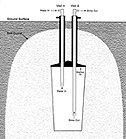Wednesday, October 26, 2005
The U.S. Department of Energy is considering Richton, Miss., as a location for the newest expansion of the Strategic Petroleum Reserve (SPR). The reserve, established in 1975 to protect the U.S. from oil supply interruptions, faced its starkest example of how much damage an interruption could pack with the onslaught of Hurricane Katrina. Gas prices, after years of steady ascension, shot up another 30 cents in some regions, so much so that President George W. Bush called upon the release of 30 million barrels of oil from the reserve. The administration has also been looking to expand the reserve, outlining in the Energy Policy Act of 2005 an expansion of the reserve from 727 million barrels of oil to 1 billion.
In an effort to follow the requirements of the Energy Policy Act, the Department of Energy's Office of Planning and Engineering held a public forum on Oct. 17 to gauge the Mississippi public's receptiveness to the idea of opening a reservoir in an area about one mile from the town of Richton.
Geologists have discovered rock salt formations from 1,000 to 6,000 feet below ground at the location, and the DOE is assembling a study to analyze the impact of cutting a reservoir into the subterranean mountain of salt using water from a nearby river. The formations were pushed up over millions of years as ancient sea salts welled up through weaknesses in overlying strata, creating a kind of salt pimple.
The DEO wants to pump fresh water into one of the formations and melt out a hole in the salt, which is known for its geographic stability, and dump oil into it. The process will create 80 million barrels of briny water for every 10 million barrels of hole created.
The forum, scheduled to run from 7 p.m. to 9 p.m. that night, did not run over one hour, particularly because of the absence of public comment and concern.
"That went shorter than I'd planned," said a very pleased David Johnson of DOE's office of planning and engineering, after delivering a summary of the process of drilling and how stable the resulting storage well should be. Oil, unlike natural gas storage of the same design, is not stored under pressure, resulting in significantly less leakage.
Still, Becky Gillette, co-executive committee chairwoman of the Mississippi Chapter of the Sierra Club, thinks the drilling itself will create briny melt water that could pose a hazard to the Coast.
"We don't particularly need saltier water on the coast. If you get too much salt water, it destroys the ecosystem, and parasites of coastal oyster beds become more prominent. Also, we need to know what the pipeline delivering that salty water back to the coast impacts. Build a pipeline from Richton to the Gulf Coast, and you'll have numerous disturbances in wetlands from here to there," Gillette said, adding that the U.S. needed to work more on conserving oil than getting it. "Our consumption of energy is causing problems with climate change and our economy, and it's a terrible pollutant. We need to curb our appetite."
Richton Mayor Jimmy White, who was among the no more than 30 in attendance, said he and his constituents approved of the plan so far, though he remained concerned that the town of Richton was not included more in the decision making.
"We're basically uninformed as to what kind of talks go on out there. We're not included in any of the discussions about the development of it," said White, who was a leader in a town movement in the 1970s opposed to using the same location for storing nuclear waste. "Whatever's out there will have an economic effect, but it'll surely affect the town's way of life in other ways, too. We just think it's important to us that we be informed."
Development in Richton remains the most costly of the four proposed sites spanning Louisiana, Mississippi and Texas. Richton would require a 96-mile brine disposal pipeline to the Gulf of Mexico and an 83-mile oil distribution pipe. Also required would be another 118-mile oil pipe to the Capline Interstate Pipeline injection station, in Liberty, Miss., and new marine oil distribution docks and storage tanks in Pascagoula.
Previous Comments
- ID
- 64766
- Comment
I like the idea of putting part the SPR there, but I think using the salt dome for natural gas would be a better use. Either way, it destoys the idea of using the domes for nuclear waste...
- Author
- Fielding
- Date
- 2005-11-01T12:02:33-06:00
- ID
- 64767
- Comment
Fielding, you're back! Good point, that if we use the salt domes for oil/gas, then we don't use them for nuclear (or nucular) waste. I remember my dad doing some research on using salt domes for nuclear waste way back when I was in high school. It'd be nice to put that notion to rest.
- Author
- kate
- Date
- 2005-11-01T12:30:50-06:00

Comments
Use the comment form below to begin a discussion about this content.
Sign in to comment
Or login with:
OpenID